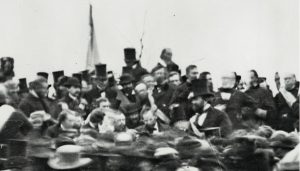On Saturday evening, March 23, 2019, Christy Coleman, CEO of the American Civil War Museum in Richmond, VA, will speak at Dickinson College from 7pm to 8:15pm at the ATS auditorium, from the lectern that was on the speaker’s platform at Gettysburg on November 19, 1863. Coleman will be delivering a keynote address for the Dickinson & Slavery initiative, entitled “Getting Right with Civil War Memory.” This event is free and open to the public. Doors open at 6pm for those who want to view the lectern or select panels from the new Dickinson & Slavery exhibit.
 Forbes magazine just recently profiled Christy Coleman as, “The Woman CEO Retelling the Story of Slavery and American History.” She grew up in Williamsburg, Virginia and earned her Bachelor’s and Master’s degrees from Hampton University. Coleman currently serves as CEO of the American Civil War Museum, located in Richmond and Appomattox, Virginia. In her role as CEO, she has been instrumental in furthering discussion around the Civil War, its legacies, and its relevance to our lives today not only in the Richmond region but around the nation. Christy strives to make museum experiences meaningful to diverse communities. A tireless advocate for the power of museums, narrative disruption and inclusivity, she has been an innovator and leader in the history museum field. She’s written numerous articles, is an accomplished screenwriter, public speaker and has appeared on several national programs. Her work has been featured in global and national publications. Time Magazine has named her one of 31 People Changing the South.
Forbes magazine just recently profiled Christy Coleman as, “The Woman CEO Retelling the Story of Slavery and American History.” She grew up in Williamsburg, Virginia and earned her Bachelor’s and Master’s degrees from Hampton University. Coleman currently serves as CEO of the American Civil War Museum, located in Richmond and Appomattox, Virginia. In her role as CEO, she has been instrumental in furthering discussion around the Civil War, its legacies, and its relevance to our lives today not only in the Richmond region but around the nation. Christy strives to make museum experiences meaningful to diverse communities. A tireless advocate for the power of museums, narrative disruption and inclusivity, she has been an innovator and leader in the history museum field. She’s written numerous articles, is an accomplished screenwriter, public speaker and has appeared on several national programs. Her work has been featured in global and national publications. Time Magazine has named her one of 31 People Changing the South.
Coleman will be speaking at Dickinson from the lectern that was on the speaker’s platform when Abraham Lincoln delivered his Gettysburg Address on November 19, 1863. This rarely seen historical relic was last used for a public address by Pope Francis when he visited Philadelphia in 2015. The lectern will be on display along with a chair from the platform used by Edward Everett, the dedication ceremony’s main orator. The two items have never before been on public display together. This remarkable installation has been made possible by the J. Howard Wert Collection. Visitors will be able to view the lectern and chair in person, along with panels from the new Dickinson & Slavery exhibit, beginning at 6pm in the Anita Tuvin Schlecter (ATS) auditorium (campus map) on Saturday, March 23d.



Background on the Collection
The J. Howard Wert Collection is considered one of the finest privately held collections of Civil War era artifacts in the country. Wert came from a prominent antislavery family in Adams County, Pennsylvania. The Wert family collected a number of important historical artifacts, dating back to the 18th century. Wert himself was a graduate of Gettysburg College who served as a scout for Union forces during the 1863 battle and was present for the Gettysburg Address later that year. Wert eventually enlisted in the Union army and became a teacher, author and noted school superintendent in Harrisburg. He died in 1920. During his lifetime, however, he was renowned for his collection of important historical artifacts. A 1910 newspaper profile claimed that Wert “had gathered a collection of relics at Gettysburg that could not be duplicated in any museum in the country.” In his own Gettysburg battlefield guide, which had been published in 1886 when he was forty-six years old, Wert wrote about how his collection of relics inspired him to try to recount the conflict for future generations:
As these lines are penned, from the walls around, cartridge-box and cap-box, bayonet and sword, canteen and canister, with a hundred other relics gleaned twenty-three years ago from the fields and woods we are now traversing, look mutely down upon the writer and vividly recall the sorrowful appearance of the bloated and distorted and blackened dead that lay close beside; noble, stalwart men were they, arrayed in garb of gray, who had bravely fought for what they deemed the right. (J. Howard Wert, A complete hand-book of the monuments and indications and guide to the positions on the Gettysburg battlefield, 1886, pp. 109-110)

Dedication Day, November 19, 1863
There are no eye-witness accounts or photographs from 1863 that actually depict the lectern or the chairs on the speaker’s platform. However, the photographs that do exist make very clear that the scene was more than a little chaotic and that most of the standing crowd would have had a limited view beyond the shoulder line of the speakers. Many of those present at the ceremony were impressed that the main orator Edward Everett seemed to have memorized his two-hour address, and some near the platform also remarked on how Lincoln slowly read his now much-more famous two-minute address, but few took note of other physical details from the platform itself. Yet, J. Howard Wert, then 22 years old, was definitely present at the ceremony. So was his friend, Henry Eyster Jacobs, a 19-year-old fellow graduate of Pennsylvania (later Gettysburg) College. His father, Michael Jacobs, was also there, and was at the time a professor at the college, writing a history of the battle. In fact, Prof. Jacobs had taken Everett on a tour of the battlefield in the days prior to the dedication ceremonies. We know this because Edwards himself mentioned the tour in his diary. Then, according to notes in the Wert Collection prepared decades later by J. Howard Wert, it was Professor Jacobs who provided his teaching lectern for the ceremony, along with at least one side chair, that was used by Everett, the former Massachusetts governor and U.S. senator while he was waiting to speak. These notes (previously unpublished), and various other relevant primary sources, including recollections by Wert and both Jacobs men, are provided below.


- Official select committee report & ceremony program (1864)
- Michael Jacobs book on battle (1864)
- Michael Jacobs article on touring battlefield: US Service Magazine with Part 2 (1864)
- J. Howard Wert battlefield guide (1886)
- J. Howard Wert recalling battle and cemetery dedication (1909): Part 1 and Part 2
- 1910 newspaper profile describing how Wert collected and annotated his battlefield relics
- Henry Eyster Jacobs on Gettysburg Address (1919)

Leave a Reply